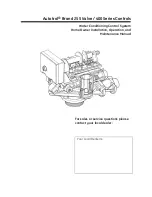
6
OPERATION/MAINTENANCE
Pressure Relief Procedure
To reduce the risk of serious bodily injury, including
fluid injection, splashing in the eyes or on the skin, or
injury from moving parts, always follow this proce-
dure whenever you shut off the pump, when check-
ing or servicing any part of the spray/dispensing sys-
tem, when installing, cleaning or changing spray
tips/nozzles, and whenever you stop spraying/dis-
pensing.
1. Engage the spray gun/dispensing valve safety
latch.
2. Shut off the air to the pump.
3. Close the bleed–type master air valve (required
in your system).
4. Disengage the gun/valve safety latch.
5. Hold a metal part of the gun/valve firmly to the
side of a grounded metal pail, and trigger the gun/
valve to relieve pressure.
6. Engage the gun/valve safety latch.
7. Open the drain valve (required in your system)
and/or the pump bleeder valve, having a con-
tainer ready to catch the drainage.
8. Leave the drain valve open until you are ready to
spray/dispense again.
If you suspect that the spray tip/nozzle or hose is
completely clogged, or that pressure has not been
fully relieved after following the steps above, VERY
SLOWLY loosen the tip guard retaining nut or hose
end coupling and relieve pressure gradually , then
loosen completely. Now clear the tip or hose.
WARNING
Packing Nut/Wet–Cup
Fill the packing nut/wet–cup (2) 1/3 full with Graco Throat
Seal Liquid (TSL) or compatible solvent. See Fig. 2. Ad-
just the packing nut weekly so it is just snug; do not over-
tighten. Follow the
Pressure Relief Procedure W arn-
ing
above before adjusting the packing nut.
Flushing the Pump
The pump is tested with lightweight oil, which is left in to
protect the pump parts. If the fluid you are using may be
contaminated by the oil, flush it out with a compatible sol-
vent before using the pump.
For your safety ,
read the warning section,
FIRE
OR EXPLOSION HAZARD
on page 3 before flush-
ing, and follow all the recommendations given there.
WARNING
Starting and Adjusting the Pump
See the
TYPICAL INSTALLATION
on page 4. If you are
using a pneumatic elevator cart or 19 liter (5 gallon) ram
with the pump, refer to the separate instructions for those
components for set–up and operation instructions.
Lower the pump into a fluid container . Be sure the air
regulator (K) and bleed–type master air valve (J) are
closed. Then open the bleed valve (J). Hold a metal part
of the spray gun/dispensing valve (S) firmly to the side of
a grounded metal pail and hold the trigger open. Now
slowly open the air regulator until the pump starts.
Moving parts can pinch or amputate your fingers or
other body parts. When the pump is operating, the
priming piston (23) (located at the pump intake) and
the air motor piston (located behind the air motor
plates) move. See Fig. 2. Therefore, NEVER oper-
ate the pump with the air motor plates removed, and
keep your fingers and hands away from the priming
piston.
Before attempting to clear an obstruction from the
priming piston (23) or service the pump, follow the
Pressure Relief Procedure Warning
at left
to pre-
vent the pump from starting accidentally.
WARNING
Cycle the pump slowly until all the air is pushed out and
the pump and hoses are fully primed. Release the spray
gun/dispensing valve trigger and engage the safety latch.
The pump should stall against pressure when the trigger
is released.
If the pump fails to prime properly, open the bleeder valve
(33) slightly. See Fig 6. Use the bleeder hole (on the un-
derside of the valve housing) as a priming valve until the
fluid appears at the hole. Close the bleeder valve.
NOTE:
When changing fluid containers with the hose
and gun already primed, be sure to open the
bleeder valve (33), to assist in priming the pump
and venting air before it enters the hose. Close
the bleeder valve when all air has been elimi-
nated.
To reduce the risk of fluid injection, DO NOT use
your hand or fingers to cover the bleeder hole when
priming the pump.
WARNING
With the pump and lines primed, and with adequate air
pressure and volume supplied, the pump will start and
stop as the spray gun/dispensing valve is opened and
closed.
Use the air regulator (K) to control the pump speed and
the fluid pressure. Always use the lowest air pressure
necessary to get the desired results. Higher pressures
cause premature tip/nozzle and pump wear.
To reduce the risk of overpressurizing your system,
which could result in component rupture and cause
serious bodily injury,
NEVER exceed the specified
MAXIMUM INCOMING AIR PRESSURE to
the
pump
(see the Technical Data on pages 20–23).
WARNING
Never allow the pump to run dry of the fluid being
pumped. A dry pump will quickly accelerate to a high
speed, possibly damaging itself. A pump runaway valve
(G), which shuts off the air supply to the pump if the pump
accelerates beyond the pre–set speed, is available. See
the Typical Installation on page 4 and
ACCESSORIES
on pages 18 and 19. If your pump accelerates quickly, or
is running too fast, stop it immediately and check the fluid
supply. If the supply container is empty and air has been
pumped into the lines, refill the container and prime the
pump and the lines with fluid, or flush and leave it filled
with a compatible solvent. Be sure to eliminate all air from
the fluid system.
Summary of Contents for Metric CHECK-MATE 200
Page 26: ...26 NOTES...
Page 27: ...27 NOTES...






































